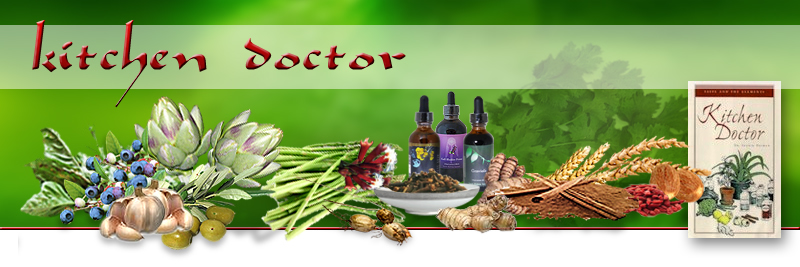The Rasayanas are mean to impart long, healthy,
disease free life, intelligence, power of memory, youth and luster.
Among all the Rasayanas, Chyawanprash is most useful and famous.
It is the most popular rejuvenating Ayurvedic tonic in India
having a consistency of Jam and consisting of about 35 natural
herbs including Amla (Embellica Officinalis) the richest natural
source of vitamin C. It works on the immune system of the body
protecting body against everyday infections like cough cold and
fever. Thus it is very useful in children, old persons, tubercular
patients and debilitated persons."
I clipped the above quote from an Indian
web site. Obsessing a little here. Those of you who have listened
to the Kitchen Doctor tapes have heard this story:
Long, long ago, there was a sage in India
named Chyawan who lived in a forest. His hair was matted and
he was covered with tree growth after years of meditating in
the same place. A young princess was blindfolded and dancing
in the forest when her hands touched the hair of the sage.
Her father, the king, explained to the sage that it was the
custom in his country that a woman could only touch one man
in her lifetime. He thus requested the sage to marry to daughter.
Chyawan asked if he could have two months to prepare for the
wedding for he wished to be young again so as to afford his
wife conjugal bliss. Thereupon, he developed the recipe for
longevity that has remained India's most popular remedy, some
say for 2000 years, others since the times of the Vedas.
Today, there are many recipes for Chyawanprash,
ranging in ingredients from a mere 20 or so herbs and spices
to 70 or 80 ingredients. However, the main ingredient, regardless
of the exact formula is always amla or amalaki,
a tropical gooseberry that is the world's richest source of vitamin
C. It is, moreover, a source that remains stable in storage for
years. The rest of the ingredients vary from regenerative herbs
for the reproductive system such as ashwagandha and shatavari
to spices that aid assimilation and digestion.
In Ayurveda, it is believed that most disease
stems from problems in the digestive system. The Iroquois and
many others share this belief. Ayurveda breaks digestion into
three stages: the stomach, the small intestine, and the large
intestines. Food that is assimilated in the stomach is used very
quickly for the building of fluids, blood and lymph. What is
assimilated in the small intestine affects mainly muscles and
fat; and what is assimilated in the colon is used to regenerate
the skin, bones, hair, nerve sheaths, reproductive fluids, and
brain. Fragility of the bones and senility are thus colon problems
and they are "vata" conditions, derangements of the
air and ether. All proper maintenance requires good digestion
and assimilation; otherwise, worn out tissues will not be regenerated,
i.e. replaced by healthy new tissues.
A "rasayana" is a formula for
just such tissue rejuvenation, and Chyawanprash is the most famous,
and in my opinion, the most effective of these highly esoteric
remedies. Moreover, it has been so thoroughly studied that it
is legal to market Chyawanprash as an antioxidant, the best that
has ever been researched in modern laboratories.
So, what I have been doing for years is
trying various Chyawanprash concoctions. I used to import one
from India produced by a lovely lady doctor named Smita Naram.
It was expensive because she used fresh amla. I tried making
my own for a while (with dry amla but the amount of honey needed
to deal with the sourness of the amla was intimidating.) I later
used a brand recommended by David Frawley. It was quite sattvic,
i.e., a little sweeter than some versions and not as spicy. For
the last couple of years, we have been carrying a nicely packaged
brand which is the same old Dabur in fancier containers. Yesterday,
I tried three versions of the Banyan Botanicals brand. They do
what everyone should have been doing for thousands of years.
They are making one especially for those with pitta derangements
that is not quite as spicy as the one for vata and kapha derangements.
I personally prefer the taste and texture of the pitta formula
but I'm a fire type. Then, they make a third one with a mixture
of Western gooseberries and amla that is "tridoshic," i.e.
balancing to all the doshas.
In my experience, the first thing that happens
with use of Chyawanprash is that assimilation of nutrients is
greatly improved, and the evidence for this is that people whose
hair tends to fall out, especially after shampooing, find that
their hair no longer falls out and that it becomes thicker and
more its natural color.
Sounding too good to be true? Little by
little, all systems of the body work better, but most especially
those that relate to the lower chakras.
In India, those with the means to afford
Chyawanprash take it every day, usually at least from age 40
onwards. They generally use about 1-3 teaspoons a day.
As one might expect, in India, many people
take Chyawanprash in warm milk, but I suggest that most people
just eat some straight from the bottle. The taste is interesting,
a bit sweet-sour in flavor. Most people are surprised that Chyawanprash
tastes as good as it does. My dogs fight over the almost empty
containers and all the dogs I've had for the last 20 years prefer
Chyawanprash to bones.
Sorry to be so wordy, but I thought many
of you would like to know about my find! Banyan's product is
very good!!
Copyright by Ingrid Naiman 2002
